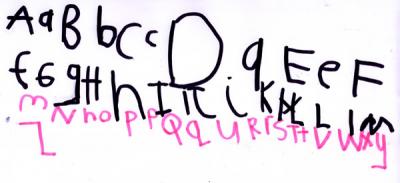Many handwriting workbooks provide young children with outlines of letters to trace. The outlines often have arrows to indicate the direction of the stroke.

It is important to remember that learning to write letters starts with learning the motor plan for the letters and being able to fluently link the successive strokes to form the letter. Once the child has mastered linking the strokes, the next step is to learn to moderate the movements to produce a letter of particular size. This takes quite bit of practice before a child can plan and control the movement so that the letter fits neatly between predetermined line.
However when a letter is drawn within the confines of an outline, the motor strategy is very different. The child draws a series of short segments and visually monitors the actions to keep between the lines.
Roan (Gr R, second term) has learned the correct stroke patterns for the majority of the letters of the alphabet, but has not yet learned to moderate the size of the letters. It is interesting that she does have quite good spacing between the letters which means that she is able to pre-plan the letter and select the correct start position for each letter.

Here you see my efforts to trace a letter. The lines are not fluent. Because the shape of the letters differs from my usual pattern I need to my movements repeatedly to fit between the lines.

This has two negative consequences. The first is that the child starts to rely on visual monitoring of the writing actions. The other is that the child does not learn the motor patterns for writing the letter.
Children with good graphic skills do not seem to be negatively influenced by tracing practice. They learn the motor plan despite the tracing practice. However for a child with poor graphic skills tracing letters has negative consequences. This is particularly true for children who tend to rely on visual monitoring of their drawing actions.
Below is an example of a worksheet and letter tracing completed by a 6 year old in kindergarten. She in fact has quite fluent letter writing abilities, but this example shows how tracing the letter produces a jagged line as she attempts to conform to the outline of the d.

.
Bibliography
Danna J, Velay JL. (2015) Basic and supplementary sensory feedback in handwriting. Front Psychol. 2015 Feb 20;6:169. doi: 10.3389/fpsyg.2015.00169. eCollection 2015. Review. PubMed PMID: 25750633; PubMed Central PMCID: PMC4335466. 2:
Danna J, Fontaine M, Paz-Villagrán V, Gondre C, Thoret E, Aramaki M, Kronland-Martinet R, Ystad S, Velay JL. (2014) The effect of real-time auditory feedback on learning new characters. Hum Mov Sci. 2014 Dec 18. pii: S0167-9457(14)00216-4. doi: 10.1016/j.humov.2014.12.002. [Epub ahead of print] PubMed PMID: 25533208.
Johnson, R. L., Culmer, P. R., Burke, M. R., Mon-Williams, M., & Wilkie, R. M. (2010). Exploring structural learning in handwriting. Experimental Brain Research. Experimentelle Hirnforschung. Experimentation Cerebrale, 207(3-4), 291–295. doi:10.1007/s00221-010-2438-5
Overvelde, A., & Hulstijn, W. (2011). Learning new movement patterns : A study on good and poor writers comparing learning conditions emphasizing spatial , timing or abstract characteristics. Human Movement Science, 30(4), 731–744. doi:10.1016/j.humov.2010.08.016
Paz-Villagrán, V., Danna, J., & Velay, J.-L. (2014). Lifts and stops in proficient and dysgraphic handwriting. Human Movement Science, 33, 381–94. doi:10.1016/j.humov.2013.11.005
Vinter, A., & Chartrel, E. (2010). Effects of different types of learning on handwriting movements in young children. Learning and Instruction, 20(6), 476–486. doi:10.1016/j.learninstruc.2009.07.001
Vinter, A., & Perruchet, P. (2002). Implicit motor learning through observational training in adults and children. Memory & Cognition, 30(2), 256–61. Retrieved from http://www.ncbi.nlm.nih.gov/pubmed/12035887

